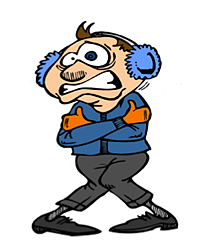
Advent of winter brings hypothermia warning
Ada City-County Emergency Managemenet
Cold weather and freezing temperatures are right around the corner as are the host of outdoor activities that many enjoy in the late fall and throughout the winter.
 However, prolonged exposure to cold weather can lead to a serious health condition called hypothermia. Recognizing and treating the symptoms are keys to keeping healthy during the upcoming season. Be aware and prepare to enjoy the winter.
However, prolonged exposure to cold weather can lead to a serious health condition called hypothermia. Recognizing and treating the symptoms are keys to keeping healthy during the upcoming season. Be aware and prepare to enjoy the winter.
What Is hypothermia?
According to the Center for Disease Prevention and Control (CDC), a person's body begins to lose heat faster than it can produce it when exposed to cold temperatures. Extended periods of time in the cold eventually will use up all of the body’s stored energy.
 The resulting abnormally low body temperature is known as hypothermia. The condition affects the brain, making it difficult for the victim to think clearly or move well. This makes hypothermia very dangerous as the person may not realize it is happening and will not take any action.
The resulting abnormally low body temperature is known as hypothermia. The condition affects the brain, making it difficult for the victim to think clearly or move well. This makes hypothermia very dangerous as the person may not realize it is happening and will not take any action.
Identifying the risks, recognizing the signs
The greatest chance for developing hypothermia is during very cold temperatures. But it can occur at cool temperatures (above 40° F) if a person becomes chilled from rain, sweat or submersion in cold water.
Hypothermia victims often are:
-
Elderly people with inadequate food, clothing, or heating
-
Babies sleeping in a cold bedroom
-
People who remain outdoors for long periods of time such as, hikers, hunters or homeless
-
People impaired by the use of illicit drugs or alcohol
Warning signs of hypothermia
Adults: Shivering, exhaustion, confusion, fumbling, memory loss, slurred speech, drowsiness
Infants: Bright red, cold skin, very low energy
Hypothermia care
If any of the warning signs are present, take the person’s temperature immediately. If the body temperature is below 95° seek medical attention right away. This is an emergency situation. If medical care is not available, start warming the person using the following steps:
-
Get the person into a warm room or shelter of some type.
-
Remove any wet clothing from the victim.
-
Warm the center of the body first to include the chest, neck, head and groin. Use an electric blanket, if available. Another alternative is to use skin-to-skin contact under loose, dry layers of blankets, clothing, towels, or sheets.
-
Warm, non-alcoholic beverages can help increase the body temperature. The victim must be conscious before being given any type of beverage.
-
Once body temperature has increased, keep the person dry and wrapped in a warm blanket. Include the head and neck either in the blanket or warm by some other method (cap, scarf).
-
Seek medical attention as soon as possible.
The CDC also emphasizes that a person with severe hypothermia may be unconscious and may not seem to have a pulse or appear to be breathing. The victim must be handled gently and receive emergency assistance immediately.
Even if the victim appears dead, cardiopulmonary resuscitation (CPR) should be administered by a qualified individual. Continue CPR while the victim is being warmed, until the victim responds or medical aid becomes available. In some cases, hypothermia victims who appeared dead have been successfully resuscitated.
Published 11-9-2012